The Schulz Museum is one of Sonoma County’s hidden gems. It’s tucked away in a quiet, rather low-income neighborhood near a dying shopping mall on the west side of Santa Rosa. After our write-in on Veterans Day, Lillian and I drove up there to check out the Poppin’ From the Panel Exhibit.
Happiness is Warm Puppy
Inside the Schulz Ice Arena, the Warm Puppy Café serves standard café fare and lets you watch the skaters. Schulz himself frequently ended a productive day of drawing in his studio by walking over to the café and having a tuna sandwich and an iced tea. If you’re going to check out the museum you should have the complete experience. Have lunch, watch the skaters, then take the crosswalk that heads due west across Hardies Lane onto the museum property.
The arena was jumping. Veterans Day was a school holiday and it was gray, drippy day; the arena was a good outing for many kids and their parents.
The Muralist is In
Darryl Burson is a muralist commissioned by the museum to put a Peanuts panel on a wall in the gallery. It’s an older strip, with a mischievous Snoopy in the starring role.
At the end of the promenade is the impressive tile mural completed by Yoshiteru Otani. The mural is in black and white, composed entirely of Peanuts strips. To get the black lines the artist had to locate and correctly place the strips that had frames with a dark background.
The museum is quite liberal about photography, but none was allowed for the current exhibit because many pieces were on loan. The theme is pop art and how it related to commercial animation and cartooning. I thought some seemed familiar; they were from the diRosa Art Preserve, so if I hadn’t seen them before I may have seen other pieces by those artists. (You can take pictures everywhere else.)
The Marriage of Commerce and Art
Three pieces in a line seemed to set the boundaries of the pop-art conversation. On the viewer’s left, the first piece was presented like a painting, but was three-dimensional, augmented with clay or acrylic sculpture medium. Corporate Kiss, by Llyn Foulkes is a self-portrait, of a dismayed and anguished-looking man. He wears a faded blue plaid shirt with a pen in the pocket. The background is desolate, a wasteland—bare, riven ground, wasted trunks of uprooted trees. The cracks and gullies in the dry earth match the furrows on Foulkes’s brow. The only primary and vibrant colors in the piece belong to the tiny copyrighted mouse perched on his shoulder, kissing his cheek. Foulke’s expression balances between shame and yearning. Foulkes hates the “corporatism” of the Disney corporation but even he can’t resist its charming mascot.
On the viewer’s right is a dark painting that almost looks like photorealism. It’s grim and dated somehow, with a round-hooded truck in the background, a phallic sign saying Liquor, and a circular sign below that with a stylized bell and clapper; Bell Telephone, hanging above an old-fashioned phone booth, the kind with the folding door. Across the dark road, in the viewer’s right foreground, is a profiled Daffy Duck, standing as high as the Liquor sign, looking brave and out of place in a little sailor outfit. Is it a case of forced perspective? Perhaps the viewer is looking out a window, with a three-inch tall duck figurine on the sill. Perhaps there really is a statue of Daffy Duck on this street with its feelings of hopelessness. Or maybe this is a Godzilla-like duck come to life, a multi-story-tall superhero. In the artist’s statement for Heat of the Night, Gottfried Helwien talks about growing up in Soviet-occupied Vienna, a place he remembers as filled with “rust and dust.” Everything was gray, drab and stagnant until his father brought home some German-language Daffy Duck comics. For the artist, commercial comics were the only source of light, change and hope.
Between these two poles, one who sees Mickey Mouse as an alluring and devastating corporate drug and one who sees comic books as a source of hope and freedom, we have Cartoon for the Last Supper, by James Barness. Painted on antique comic strips like The Apache Kid, the piece features a group of characters in a pose not unlike daVinci’s painting. Some of the characters are funny, others are comic-book strange, and they have large eyes that stare out at the viewer with a gaze somewhere between human and canine.
At the end of this row there is a Superman portrait painted by Mel Ramos. At first glance it is a classic Man of Steel pose, until the viewer looks more closely. Superman’s fists are furled but not clenched, and he is frowning slightly, the frown depicted by a single downward slash of paint. He looks. . . lost, confused. More than that, abandoned, maybe. Lillian put his words to the painting. “ ‘Where did they go?’” she wondered. If we don’t need the Man of Steel anymore, what will he do?
Spidey No More, around the corner, by the same painter, is a poignant and whimsical painting of Charlie Brown assuming the role of Spiderman. Next to it is Thor Versus the Silver Surfer, with Snoopy as the surfer. It is a fun piece, but the Spiderman piece is more thought-provoking.
There is also a concept piece from Christo and Jean-Claude. Okay, I’ve never understood Christo and there is a not-so-secret part of me that thinks he is less artist than scam-artist. I will admit some of the big installations, like the poppies, and the panels of fabric in Central Park looked cool. Anyway, this was a doghouse covered in canvas and rope. I rolled my eyes. Snoopy’s house, yeah, I get it. I didn’t really get it, though, until I went upstairs to the Schulz gallery and found out about the Christo connection. In one strip, Snoopy ruminates about Cristos’ work (which he likes)—he talks about the running fence, the Colorado installation, and wonders what Christo will do next. The final frame is Snoopy’s house, covered in canvas and rope. The three-dimensional piece downstairs is homage, created twenty-five years later.
These are only a few of the images in the display, which runs through December 11.
Enter the Labyrinth
The museum features a labyrinth in the shape of Snoopy’s head. It is right off the road, but somehow the little labyrinth creates an atmosphere of peace and serenity. Behind the main gallery, a small sculpture garden holds Peanuts-themed works including a holographic birdbath, and a giant rendition of Charlie Brown’s sweater.
True Colors
This time of year, the trees are showing shades of gold and crimson, flags of color against the cloudy backdrop.
The Schulz Center offers a lot more than just pop-art. They have a replica of Schulz’s studio and a video loop that describes his process and how he worked, a gallery that rotates Peanuts exhibits, and a large education center. They offer regular presentations and speakers, mostly about art and cartooning, but also about things like NASA. They were having some kind of hands-on workshop for young artists the day we were there.
1600 Words
I did manage to make a dent in my Nanowrimo word count. I do want to say a few words about the volunteers and docents at the museum. They are all friendly, helpful and well-versed in the exhibits—not only the standing Schulz exhibits but the on-loan displays as well. This is a great local trip, and a perfect outing for those out-of-town guests who may be coming in for the holidays.

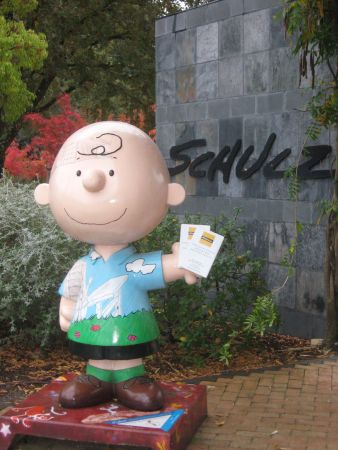
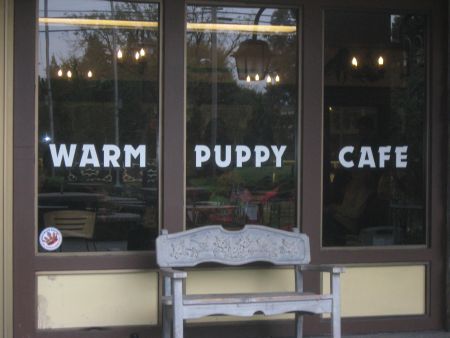
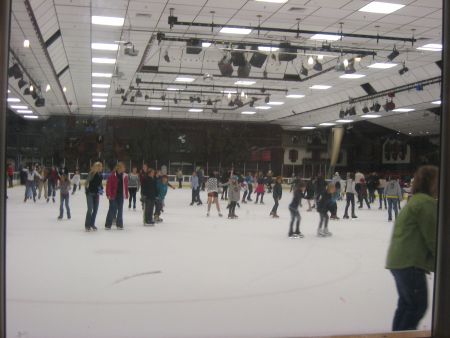
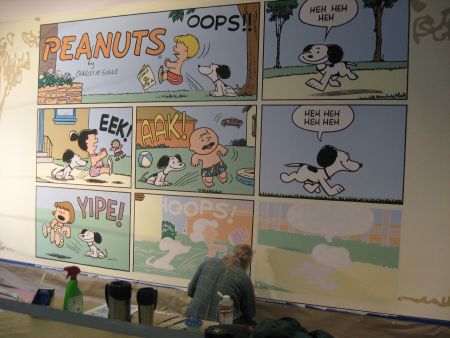
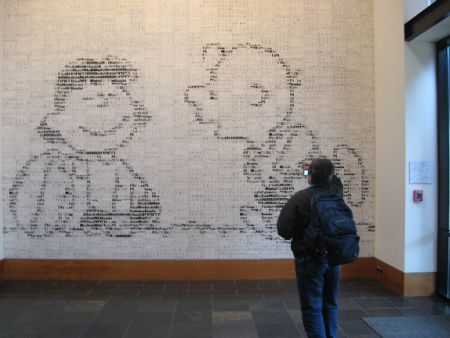
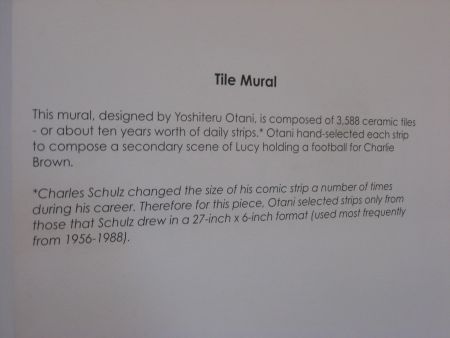


Oh, Marion,
You know, some of us would enjoy our “quiet, rather low-income neighborhood near a dying shopping mall,” even if it didn’t have the Warm Puppy Cafe!
John
It’s a lovely quiet, rather low income neighborhood near a dying mall, John.